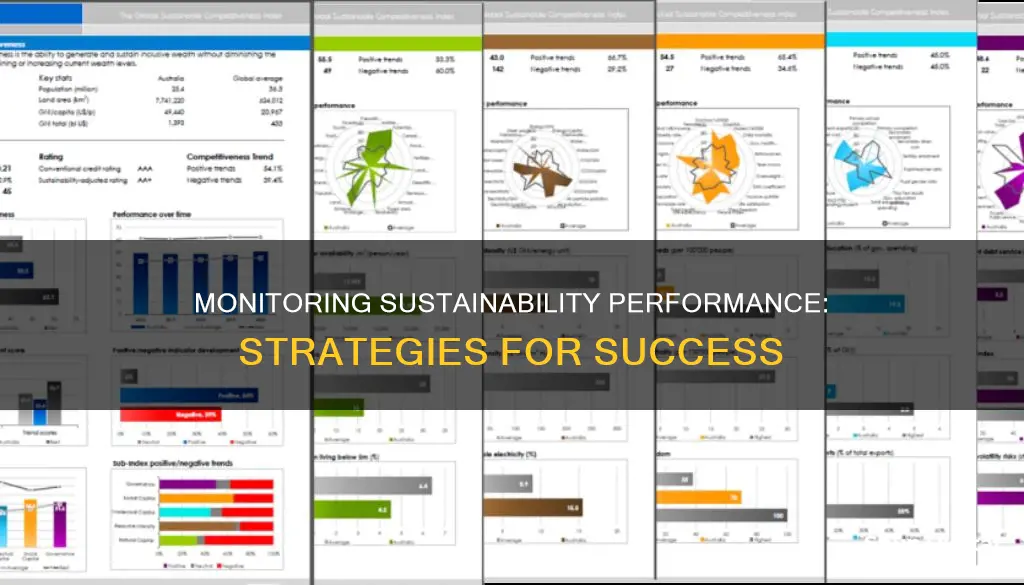
Sustainability performance is a crucial aspect for organisations aiming to strike a balance between economic viability and social and environmental responsibility. By measuring their sustainability performance, companies can gain deeper insights into their impact on the environment, society, and the economy. This involves evaluating factors such as resource consumption, waste generation, greenhouse gas emissions, and social practices. To achieve this, organisations employ various tools and frameworks, including sustainability software solutions, data collection instruments, and established standards such as the Global Reporting Initiative (GRI) or the Sustainability Accounting Standards Board (SASB). The process of monitoring sustainability performance is a collaborative effort, requiring engagement from internal and external stakeholders. It is essential for organisations to set clear goals, integrate sustainability into their business strategies, and leverage technology to enhance their sustainability journey.
| Characteristics | Values |
|---|---|
| Environmental Metrics | CO2 emissions reduction, energy consumption, water usage, waste reduction, plastic reduction, noise pollution, compliance with chemical safety requirements, compliance with environmental standards, number of suppliers audited against environmental standards |
| Social Metrics | Employee welfare, diversity and inclusion, human rights goals, living conditions, work-life balance, working hours, people development, community engagement, volunteering hours |
| Economic Metrics | Profitability, cost savings, return on investment, value creation, energy efficiency, waste reduction, resource optimization |
What You'll Learn

Tracking progress
Indicators and Metrics
Sustainability measurement involves using a set of frameworks or indicators to assess the sustainability of processes, products, services, and businesses. While there is no universally accepted system for sustainability tracking, some widely used indicators include environmental, social, and economic metrics. Environmental sustainability metrics cover areas such as CO2 emissions, energy consumption, water usage, waste reduction, and compliance with environmental standards. Social metrics include factors like labour practices, human rights, diversity, community engagement, and stakeholder satisfaction. Economic metrics assess profitability, cost savings, return on investment, and value creation. These metrics provide a comprehensive view of an organization's sustainability performance.
Data Collection and Analysis
To effectively track progress, organizations should utilize data collection and analysis tools. Surveys, questionnaires, Internet of Things (IoT) devices, Life Cycle Assessment (LCA) tools, advanced analytics, and artificial intelligence (AI) are all valuable methods for gathering and interpreting data related to sustainability metrics. These tools enable organizations to make informed decisions, identify areas for improvement, and drive positive change.
Sustainability Software Solutions
Sustainability software solutions are comprehensive platforms that assist organizations in managing their sustainability performance. These solutions offer functionalities for data collection, analysis, reporting, and performance tracking. They help organizations collect, store, and manage sustainability data efficiently, ensuring data accuracy and streamlining reporting processes. Integration with other systems, such as ERP or CRM, further enhances data accuracy and promotes seamless information sharing.
Regular Reporting and Goal Setting
Regular reporting on sustainability performance is essential for tracking progress. Organizations should establish clear goals and targets that align with global sustainability objectives, such as the United Nations Sustainable Development Goals. By setting measurable objectives and tracking key performance indicators (KPIs), organizations can monitor their progress, identify areas of improvement, and adjust their strategies accordingly.
Stakeholder Engagement
Engaging with internal and external stakeholders is crucial for tracking sustainability progress. Organizations should involve employees, customers, suppliers, and local communities in their sustainability initiatives to gain valuable insights and build trust. By communicating their sustainability performance and creating channels for open dialogue, companies can improve their practices and ensure their efforts are aligned with the expectations and interests of their stakeholders.
In conclusion, tracking progress in sustainability performance involves the effective utilization of indicators, metrics, data collection tools, software solutions, regular reporting, goal setting, and stakeholder engagement. By combining these strategies, organizations can accurately monitor their sustainability journey and make informed decisions to drive positive environmental and social change.
Finding Your MSI Monitor Invoice: A Simple Guide
You may want to see also

Show impacts
Showing the impacts of sustainability performance is a key aspect of monitoring and communicating an organisation's progress. This involves measuring and reporting on the organisation's impact on the environment, society, and the economy.
Environmental Impact
To show their environmental impact, organisations can track factors such as resource consumption, waste generation, energy usage, water consumption, and greenhouse gas emissions. By collecting data on these metrics, organisations can establish a baseline to understand their environmental footprint and identify areas for improvement. For example, they can measure their carbon emissions and work towards reducing them by migrating to more renewable energy sources.
Social Impact
Measuring social metrics allows organisations to assess their impact on society, employees, and communities. This includes evaluating labour practices, human rights, diversity and inclusion, community engagement, and stakeholder satisfaction. By measuring these factors, organisations can ensure ethical practices, fair treatment of employees, and support for local communities.
Economic Impact
Economic metrics assess the financial aspects of sustainability, such as profitability, cost savings, return on investment, and value creation. By measuring these metrics, organisations can identify opportunities for cost reduction through initiatives like energy efficiency, waste reduction, and resource optimisation.
Overall Impact
The overall impact of an organisation's sustainability performance is often presented using the triple bottom line framework, where E stands for environment, S for social, and G for governance. This framework is widely used by impact investors, banks, funds, and other organisations to evaluate the comprehensive impact of a company's activities.
By tracking and communicating their sustainability performance, organisations can demonstrate their progress, identify areas for improvement, and enhance their reputation by building trust with stakeholders, including customers, employees, investors, and the wider community.
Efficiently Eliminating That Pesky Point on Your Monitor
You may want to see also

Gaining green growth
Embed Sustainability in Daily Activities
Embedding sustainability into the daily activities of an organization is crucial. This means focusing on concrete and measurable actions that contribute to social issues and reducing any harm to the environment. By prioritizing sustainability, companies can identify areas where positive progress is being made and areas where more effort is needed. This involves consistently collecting data and tracking the progress of different sustainable initiatives.
Build Resilient Supply Chains
Resilient supply chains that can adapt to global catastrophes, pandemics, and climate change-related extreme weather conditions are critical components of holistic sustainability strategies. The COVID-19 pandemic, for example, disrupted the functioning of supply chains and markets, and businesses with sustainable practices in place prior to the pandemic experienced less negative stock returns during the market turbulence.
Integrate ESG Practices
Integrating environmental, social, and governance (ESG) practices into all operations and managing them for the long term is essential for tackling unexpected shocks and societal issues. Impact investors, banks, funds, and other organizations increasingly use the ESG framework to evaluate companies' impacts. By positively affecting society and making a difference for customers, employees, and other groups, companies can attract impact investors and increase stakeholder engagement.
Adopt Circular Economy Practices
Circular economy practices aim to decouple economic growth from resource consumption and waste generation. This involves creating closed-loop systems where products are designed for durability, reparability, and recyclability. By extending the lifespan of products and reducing waste, companies can improve their green growth and contribute to a more sustainable future.
Embrace Renewable Energy
Renewable energy offers numerous benefits for sustainable growth, including providing a clean and abundant energy source, mitigating climate change impacts, and reducing greenhouse gas emissions. By transitioning to more renewable energy sources, companies can reduce their environmental footprint and improve their resilience to global energy market volatility.
In conclusion, gaining green growth is about more than just environmental initiatives. It involves social and economic aspects, and it requires a holistic approach that considers the long-term viability of an organization's practices. By tracking progress, showing impacts, and engaging with stakeholders, companies can achieve green growth and contribute to a more sustainable world.
Monitoring Sales Staff Performance: Strategies for Effective Evaluation
You may want to see also

Engaging with stakeholders
Identify and Prioritize Stakeholders
The first step is to identify all relevant stakeholders, including internal stakeholders such as employees and management, and external ones such as suppliers, customers, local communities, regulatory authorities, and investors. Each group has different interests, levels of influence, and interactions with the company. Prioritization of stakeholders is dynamic and should be based on their influence and interest in the company's sustainability initiatives. This prioritization may change over time as the company's sustainability journey evolves and stakeholders' interests and influence shift.
Understand Stakeholders' Perspectives
Understanding stakeholders' perspectives, concerns, and expectations is essential for effective engagement. The goal is to gather their opinions and identify common themes and concerns that need to be addressed in sustainability projects. This can be achieved through surveys, meetings, social media interactions, or direct communications.
Co-creation and Planning
Once stakeholders' perspectives are understood, involve them in the planning process. This may include creating teams or holding brainstorming sessions to encourage collaboration and ensure that sustainability strategies are robust and relevant.
Regular Communication and Engagement
Maintain ongoing communication with stakeholders, providing regular updates on project progress, challenges, and milestones. Ensure a two-way communication channel where stakeholders can provide continuous feedback and suggestions.
Empowerment
Empowerment is crucial to stakeholder engagement. Provide stakeholders with the necessary resources, information, and decision-making authority to enhance their involvement and commitment to the project.
Monitoring and Feedback
Establish mechanisms to monitor the impact of stakeholder engagement and gather their feedback. Demonstrating tangible results from their involvement reinforces their sense of belonging and commitment. Communicate these results back to stakeholders to maintain transparency and trust.
Build Lasting Relationships
Stakeholder engagement is about building strong relationships with stakeholders. By doing so, organizations can minimize risks, identify emerging opportunities, and adapt to changes in the operational environment.
By effectively engaging with stakeholders, companies can achieve their sustainability goals, promote a culture of shared responsibility, and embark on a collaborative journey towards a more sustainable and equitable future.
The Ultimate Guide to Calibrating Your ASUS Monitor
You may want to see also

Communicating performance
Data and Transparency
Transparency is vital for effective communication. It means providing accurate and up-to-date information about the company's sustainable actions and their impacts. This includes disclosing both successes and failures, as honesty builds trust with stakeholders. Real-time data and examples are essential to demonstrate the company's progress and achievements.
Clear and Understandable Information
Sustainability communication should be presented in a clear and understandable manner. Using simple language and visual aids, such as graphs and charts, can make complex data more accessible to diverse audiences. This ensures that stakeholders from various backgrounds can easily interpret the information and draw meaningful insights.
Engagement with Stakeholders
Communication should focus on engaging internal and external stakeholders. This includes employees, customers, investors, suppliers, and local communities. By presenting sustainability performance regularly and creating channels for open dialogue, companies can foster collaboration and trust while gaining valuable feedback for improvement.
Alignment with Global Sustainability Goals
It is essential to align the company's sustainability goals with global initiatives, such as the United Nations Sustainable Development Goals (SDGs). This demonstrates the company's commitment to broader societal goals and contributes to a unified effort for a sustainable future.
Integration with Brand Reputation
Effective communication of sustainability performance enhances brand reputation. Companies that can showcase their commitment to sustainability through transparent reporting and measurable actions build a positive image. This attracts impact investors, increases customer loyalty, and improves relationships with various stakeholders.
Utilization of Technology
Technology plays a crucial role in enhancing sustainability communications. Digital platforms and blockchain technology enable real-time monitoring and control of key indicators, such as energy consumption and emissions. They also ensure ethical sourcing and responsible practices throughout the supply chain, providing data-driven insights for decision-making.
In summary, communicating sustainability performance is about transparency, engagement, and accountability. By effectively conveying their sustainable actions and impacts, companies can build trust, enhance their brand, and contribute to a positive future for both society and the environment.
Monitoring Your Child's Apple Devices: A Parent's Guide
You may want to see also
Frequently asked questions
Monitoring sustainability performance helps organisations take action, be accountable, and make a positive environmental and social impact. It enables them to identify areas for improvement, reduce their environmental footprint, and enhance social responsibility. Additionally, it enhances brand reputation and stakeholder trust, as consumers and investors increasingly prioritise sustainability.
Organisations can use sustainability software solutions and data collection instruments to monitor their sustainability performance. Sustainability software solutions help with data management, reporting, integration with other systems, resource optimisation, energy efficiency, and performance tracking. Data collection and analysis tools, such as surveys, questionnaires, Internet of Things (IoT) devices, Life Cycle Assessment (LCA) tools, advanced analytics, and Artificial Intelligence (AI), are also crucial for accurate measurements.
Key indicators for measuring sustainability include environmental, social, and economic domains. Environmental sustainability metrics cover climate, waste, and energy use, such as CO2 emissions, energy consumption, water usage, waste reduction, and compliance with environmental standards. Social metrics include labour practices, human rights, diversity, community engagement, and stakeholder satisfaction. Economic metrics assess profitability, cost savings, return on investment, and value creation.
Sustainability performance helps organisations mitigate risks, foster innovation, and capitalise on emerging opportunities. By managing their environmental and social impacts, organisations can proactively identify potential risks associated with climate change, resource scarcity, regulatory changes, and social issues. Additionally, it contributes to long-term economic viability by driving faster growth, attaining higher valuations, reducing costs, and attracting impact investors.
Monitoring sustainability performance can be challenging due to data quality issues, comparability, objective function, and resource constraints. Additionally, there is no globally accepted system for sustainability tracking and reporting, although the GRI Standard is used by 73% of the world's 250 largest companies. Sustainability is also difficult to quantify and measure due to the lack of a fixed definition.







